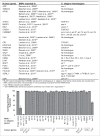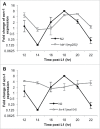acn-1, a C. elegans homologue of ACE, genetically interacts with the let-7 microRNA and other heterochronic genes
- PMID: 28933985
- PMCID: PMC5628652
- DOI: 10.1080/15384101.2017.1344798
acn-1, a C. elegans homologue of ACE, genetically interacts with the let-7 microRNA and other heterochronic genes
Abstract
The heterochronic pathway in C. elegans controls the relative timing of cell fate decisions during post-embryonic development. It includes a network of microRNAs (miRNAs), such as let-7, and protein-coding genes, such as the stemness factors, LIN-28 and LIN-41. Here we identified the acn-1 gene, a homologue of mammalian angiotensin-converting enzyme (ACE), as a new suppressor of the stem cell developmental defects of let-7 mutants. Since acn-1 null mutants die during early larval development, we used RNAi to characterize the role of acn-1 in C. elegans seam cell development, and determined its interaction with heterochronic factors, including let-7 and its downstream interactors - lin-41, hbl-1, and apl-1. We demonstrate that although RNAi knockdown of acn-1 is insufficient to cause heterochronic defects on its own, loss of acn-1 suppresses the retarded phenotypes of let-7 mutants and enhances the precocious phenotypes of hbl-1, though not lin-41, mutants. Conversely, the pattern of acn-1 expression, which oscillates during larval development, is disrupted by lin-41 mutants but not by hbl-1 mutants. Finally, we show that acn-1(RNAi) enhances the let-7-suppressing phenotypes caused by loss of apl-1, a homologue of the Alzheimer's disease-causing amyloid precursor protein (APP), while significantly disrupting the expression of apl-1 during the L4 larval stage. In conclusion, acn-1 interacts with heterochronic genes and appears to function downstream of let-7 and its target genes, including lin-41 and apl-1.
Keywords: APP; acn-1; developmental timing; heterochronic genes; let-7; lin-41.
Figures




Similar articles
-
The expression of the Alzheimer's amyloid precursor protein-like gene is regulated by developmental timing microRNAs and their targets in Caenorhabditis elegans.Dev Biol. 2008 Mar 15;315(2):418-25. doi: 10.1016/j.ydbio.2007.12.044. Epub 2008 Jan 8. Dev Biol. 2008. PMID: 18262516 Free PMC article.
-
Caenorhabditis elegans period homolog lin-42 regulates the timing of heterochronic miRNA expression.Proc Natl Acad Sci U S A. 2014 Oct 28;111(43):15450-5. doi: 10.1073/pnas.1414856111. Epub 2014 Oct 15. Proc Natl Acad Sci U S A. 2014. PMID: 25319259 Free PMC article.
-
Role of PRY-1/Axin in heterochronic miRNA-mediated seam cell development.BMC Dev Biol. 2019 Jul 15;19(1):17. doi: 10.1186/s12861-019-0197-5. BMC Dev Biol. 2019. PMID: 31307392 Free PMC article.
-
An elegant miRror: microRNAs in stem cells, developmental timing and cancer.Chromosoma. 2009 Aug;118(4):405-18. doi: 10.1007/s00412-009-0210-z. Epub 2009 Apr 3. Chromosoma. 2009. PMID: 19340450 Free PMC article. Review.
-
Heterochronic control of AFF-1-mediated cell-to-cell fusion in C. elegans.Adv Exp Med Biol. 2011;713:5-11. doi: 10.1007/978-94-007-0763-4_2. Adv Exp Med Biol. 2011. PMID: 21432011 Review.
Cited by
-
Control of aging by the renin-angiotensin system: a review of C. elegans, Drosophila, and mammals.Front Pharmacol. 2022 Sep 14;13:938650. doi: 10.3389/fphar.2022.938650. eCollection 2022. Front Pharmacol. 2022. PMID: 36188619 Free PMC article. Review.
-
The ACE inhibitor captopril inhibits ACN-1 to control dauer formation and aging.Development. 2024 Feb 1;151(3):dev202146. doi: 10.1242/dev.202146. Epub 2024 Feb 12. Development. 2024. PMID: 38284547 Free PMC article.
References
-
- Pasquinelli AE, Ruvkun G. Control of developmental timing by micrornas and their targets. Annu Rev Cell Dev Biol [Internet]. 2002;18:495-513. Available from: http://www.ncbi.nlm.nih.gov/pubmed/12142272. doi:10.1146/annurev.cellbio.18.012502.105832 - DOI - PubMed
-
- Moss EG. Heterochronic genes and the nature of developmental time. Curr Biol [Internet]. 2007;17:R425-34. Available from: http://www.ncbi.nlm.nih.gov/pubmed/17550772. doi:10.1016/j.cub.2007.03.043 - DOI - PubMed
MeSH terms
Substances
LinkOut - more resources
Full Text Sources
Other Literature Sources
Research Materials
Miscellaneous
